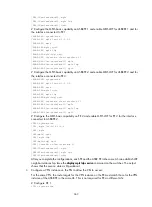
354
Step Command
Remarks
4.
Configure the CE as the VPN
EBGP peer.
peer
ipv6-address
as-number
as-number
N/A
5.
Redistribute the routes of the
local CEs.
import-route
protocol
[
process-id
]
[
med
med-value
|
route-policy
route-policy-name
] *
A PE must redistribute the routes of
the local CEs into its VPN routing
table so that it can advertise them
to the peer PE.
6.
Configure a filtering policy to
filter the routes to be
advertised.
filter-policy
{
acl6-number
|
ipv6-prefix
ipv6-prefix-name
}
export
[
direct
|
isisv6
process-id
|
ripng
process-id
|
static
]
Optional.
By default, BGP does not filter
routes to be advertised.
7.
Configure a filtering policy to
filter received routes.
filter-policy
{
acl6-number
|
ipv6-prefix
ipv6-prefix-name
}
import
Optional.
By default, the PE does not filter
received routes.
2.
Configure the CE:
Step Command
Remarks
1.
Enter system view.
system-view
N/A
2.
Enter BGP view.
bgp
as-number
N/A
3.
Enter IPv6 BGP subaddress
family view.
ipv6-family
N/A
4.
Configure the PE as the EBGP
peer.
peer
ipv6-address
as-number
as-number
N/A
5.
Configure route redistribution
and advertisement.
import-route
protocol
[
process-id
]
[
med
med-value
|
route-policy
route-policy-name
] *
Optional.
A CE needs to advertise its VPN
routes to the connected PE so that
the PE can advertise them to the
peer CE.
NOTE:
•
After an IPv6 BGP-VPN instance is configured, exchange of BGP routes for the VPN instance is the same
as exchange of ordinary BGP routes.
•
The configuration commands available in IPv6 BGP-VPN instance view are the same as those in IPv6
BGP subaddress family view. For more configuration commands in the two views, see
Layer 3—IP
Routing Configuration Guide.
Configuring routing between PEs
Step Command
Remarks
1.
Enter system view.
system-view
N/A
2.
Enter BGP view.
bgp
as-number
N/A
3.
Configure the remote PE as
the peer.
peer
ip-address
as-number
as-number
N/A
















































